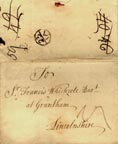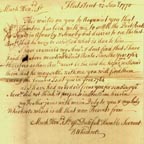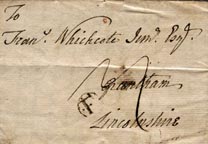Eunice and Ron Shanahan have shared with readers of the Victorian Web this material from their website, Letters from the Past. Click on thumbnails for larger images.
 These ‘Letters from the Past’ are both from the 1770’s addressed
to Francis Whichcote of Grantham, Lincolnshire. They gave me many hours of interest
researching the postal markings and the contents. The first letter is dated
23 January, 1770 - three days before the British flag was placed on Australian
soil. It is clearly addressed
These ‘Letters from the Past’ are both from the 1770’s addressed
to Francis Whichcote of Grantham, Lincolnshire. They gave me many hours of interest
researching the postal markings and the contents. The first letter is dated
23 January, 1770 - three days before the British flag was placed on Australian
soil. It is clearly addressed
To
Sr. Francis Whichcote Bart.
at Grantham
Lincolnshire
It has a scrawl on it like a snake, which usually denoted the amount of postage to be paid, which at this time would have been 4pence for a single sheet for a distance over 80 miles. (Grantham was 106 miles from London). The reverse side has an excellent Bishop Mark, of 23rd January, a black, 17mm bisected circle with the date above the month 23 IA, in sanserif letters. This type of Bishop Mark was in use at the Inland Office from 1713 to 1787. There is also a faint black Receivers Mark of RJ in a circle, which - according to the records listed in the British County Catalogue of Postal History (Willcocks and Jay: London) - would be Richard Jones, who held the post of Receiver in the Temple office of the General Post from 1766-91. In addition there are four figures written in ink, three of them crossed out, which seem to be calculations for the sums mentioned in the letter.
" Fleet Street London 23 Jan 1770
Much Honrd. Sir
This waits on you to acquaint you that Mr Taunton has been with me to settle the Quit Rents for lands in Aswarby and Swarby, but desires to see the Rents that he may be satisfied what is due to him.
I have examined my Acct. and don’t find that I have paid the above mentioned quit rent since the year 1764, therefore as those accts must be the last he hopes you will send them that he may settle with me — you will find them among the voucher I sent you in year 1764.
As I have no orders from you for sending your Acct did not think it proper to inclose them herein.
My brother joins with me in Duty to you and my Lady Whichcote, which is all that now Presents from
Much Honrd Sr. Yr Dutifull Humble Servant
B Whichcote."
I find it interesting that the writer of the letter is also a Whichcote - considering the sycophantic end to the letter, it sounds like a poor relation who was employed by the Baronet.
At the time these letters were written, the system of land tenure was complicated, and the Lord of the Manor could lease the properties on the estate under different conditions. These could include a lease for life, (with or without limitations), the owner of which was designated a Freeholder; or simply to a tenant, designated a Copyholder. One of the conditions of life then was that the tenants, workers, freeholders were obliged to give service to the Lord of the Manor for a set number of days a year (for whatever reason). This could be avoided by paying a sum of money - a ‘Quit Rent’. In fact, many of the letters owned by postal historians are to and from legal eagles with demands and opinions concerning land, tithes and titles.

 Click
on the images for larger views
Click
on the images for larger views
The second letter also has a bisected circle Bishop Mark, dated 5 OC, and in addition it has a very clear Receiver’s Mark a letter F in a circle. This was applied by William Flexney who held this position at the Grays Inn General Post Receiving Office from1759-1792.
The postal charge is also a scrawled mark, which looks like a 3. This is inexplicable as the rate from 1711 had been increased to 4d and it was unlike the Post Office officials to rate the letters incorrectly. The letter is from a lawyer in London, apparently giving a legal opinion about the payment of tithes. It is addressed presumably to the son of Sir Francis.
"Frans. Whichcote Junr. Esqr.
Grantham Lincolnshire."
The address inside the letter is one of the buildings comprising the Inns of Court, belonging to four legal societies having exclusive right of admitting persons to practise at the Bar, the other three being Inner Temple, Middle Temple and Lincoln’s Inn, London.
"Grays Inn, October 5, 1772
Sir,
Till the recpt of your favour of the 1st instant which I received this morning on my return to town, was entirely unacquainted that the fen lands in Timberlands formerly belonged to Kirksted Abby, which I now find was of the Cistercian Order and was one of those orders which were generally held to be discharged from the payment of tithes, whilst in the actual occupation and manorance of the owners of those lands, but not otherwise.
So that if Mr Lucas or Mr Disney - the owners - choose to live upon, occupy and manorce (sic.) their own lands to be allotted to them in the fens, it will be somewhat extraordinary. But if they do not, but Let them to tenants, those lands in the hands of the tenants are undoubtedly subject to the payment of tithes to the Rectory of Timberlands and therefore was it my case.
I should choose to have it previously settled and agreed upon that the lands to be allotted me on an Inclosure should be nearest to the Town, as then there would be the less probability of the owners taking into their own hands their lands in the middle of the Fens.
I am sir, your most humble servt.
Richd. Morland."
This last paragraph concerns the Enclosure of land, which was a very controversial subject at that time. The principle behind the enclosure system was ‘Bigger is Better ‘. It was more efficient to farm in larger units, rather than the method then used by the peasants of farming strips of land, and using common or waste land to graze their animals. But it was expensive to carry out the Enclosures, which involved surveys, fencing and hedging etc, and the costs could not be met by the small farmers. Many of them simply sold out and joined the landless labourers.
Enclosures were not new, but they escalated between 1750 and 1780 to such an extent that more than three million acres of strips, waste and common land were enclosed as a result of 1200 Enclosure Acts being passed by Parliament. As this coincided with an increase in the population, the effect was increased poverty in the countryside, because the smallholders were deprived of their land, and their common grazing rights, so they were unable to feed themselves. In contrast, as this letter indicates, their land in Lincolnshire was to be enclosed, and some of it allotted to Richard Morland, a ‘legal eagle’ practising in London, more than 100 miles - a day’s journey - away. His request regarding the land to be allotted to him shows that he was aware of possible problems!
Last modified 19 December 2002